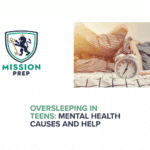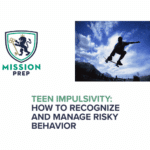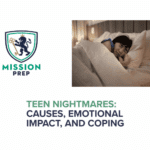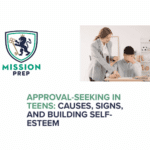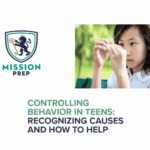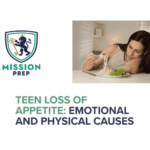Sleep Paralysis in Teens: Symptoms, Causes, and Coping Tips

Sleep paralysis occurs when a person’s body is completely immobilized either immediately after falling asleep or just before waking up.1 Experiencing an episode of sleep paralysis can cause panic because when it happens, you can’t talk or move, but you remain aware of your surroundings and are fully conscious.
If your teenager goes through one of these episodes, it might not be a cause for concern. However, if your child is regularly experiencing sleep paralysis, it’s time to look into other potential underlying health conditions.
Besides being terrifying, sleep paralysis is often linked to other sleep issues in teens and can even be a sign of a serious mental health problem. If you’re not familiar with sleep paralysis, or you think you need to learn more to help your child, this article is for you.
The following sections focus on teen sleep paralysis and cover these core concepts:
- The importance of teen wellness and reset
- Causes of sleep paralysis in adolescents
- Sleep disorders
- Recognizing sleep-related mental health symptoms
- Therapy for sleep disorders
- Parental support for sleep paralysis
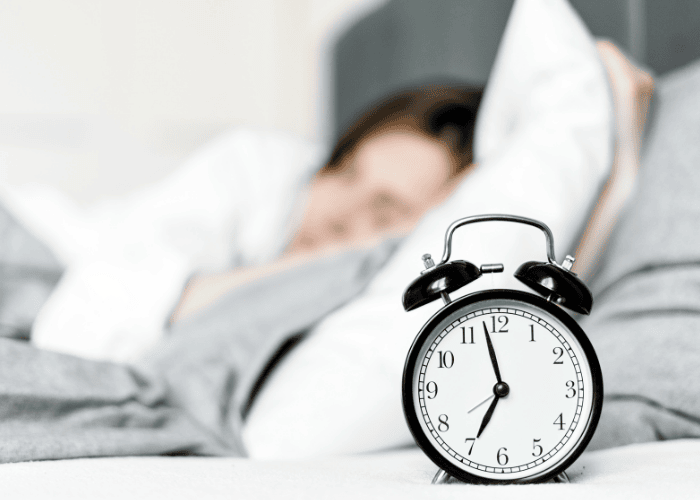
The Importance of Teen Wellness and Rest
Sleep plays an important role in our brain and body health, especially in adolescence. Importantly, adolescence is known to cause changes in sleep due to altered brain processes known as circadian rhythms.
Teens today commonly face a problem with lack of sleep or sleep deprivation due to these changes in their body.2 This lack of sleep can affect your child’s emotional processing. Children who do not get the recommended amount of sleep are at an increased risk of showing increased aggression, poorer driving, substance use, and more physical injuries.2
So, it’s clear that rest is an important part of teens staying both emotionally and physically healthy. But what causes sleep paralysis in the first place? More on this next.
Causes of Sleep Paralysis in Adolescents
Stress and Sleep Disturbances
There is a cyclical relationship between stress and sleep problems, meaning that while increased stress can cause sleep issues, sleep deprivation also increases stress. Poor sleep quality due to stress is associated with adolescent onset of sleep paralysis. Academic stress is one area that has been studied closely as it relates to sleep disorders in teens. Students who study topics that come with more pressure have shown higher rates of sleep paralysis. In addition, how individuals handle stress plays a key role in how it impacts sleep. Teens who struggle to regulate their emotions, or who have high anxiety levels, tend to experience more episodes of sleep paralysis.Poor Sleep Hygiene
Sleep hygiene refers to the routine you follow before bedtime. Not following a set schedule for sleeping and waking is a major cause of sleep problems in teens. Also, increased use of technology right before sleep negatively affects sleep quality and decreases the duration of sleep.1 Promoting healthy sleep hygiene in your child can help protect them from experiencing major sleep disturbances. Consider turning off the phones and computers at least one hour before bedtime, keeping the bedroom quiet and cool, and avoiding caffeine later in the day.Melatonin and Light Exposure
As we mentioned, disruptions in our sleep cycle are related to changes in the brain. Melatonin is a hormone that is supposed to be released during the nighttime to help keep our sleep cycle steady. However, if we are exposed to a lot of light later in the day, this can stop melatonin from being released and that, in turn, delays sleep onset. Likewise, if you aren’t getting enough exposure to sunlight during the day, your melatonin levels shift, and it puts you at risk for having sudden changes in active sleep (REM sleep).3Eating Habits
Adolescents who don’t eat a regular breakfast have shown more disruptions in sleep over the years. Studies showed the effects of skipping breakfast in young adults and found that it made it harder for them to fall asleep at night. Eating at inappropriate times throughout the day and skipping other meals are also associated with more sleep problems and even higher rates of mood disorders.2Other Influential Factors
There are, of course, other areas that have been studied with sleep paralysis in teens, such as gender differences, ethnicity, and specific genes. While there is promising research, many of these areas still need to be studied further to come to clear conclusions about their direct relationship with sleep paralysis in teens.2Sleep Disorders
Sleep paralysis as an isolated episode isn’t necessarily considered a sleep disorder. However, sleep paralysis is a symptom of other well-known sleep problems that require prompt diagnosis.
Narcolepsy is one sleep disorder closely tied to sleep paralysis. Narcolepsy is a rare neurological disorder and, in addition to sleep paralysis, can cause daytime sleeping and an inability to control when you fall asleep. Narcolepsy has also been linked to psychiatric disorders and lower reported emotional and health quality of life measures.
Restless leg syndrome (RLS) is another neurological disorder that affects sleep. RLS involves intense urges to move your legs and a feeling of crawling and creeping along with the urge. RLS is also associated with an increased risk of depression, suicide, and self-harm.3
Nightmare disorders, night terrors, sleep eating, and sleep apnea are other common sleep disorders that teens can experience.
Overall, there are many different types of sleep disorders that can contribute to sleep paralysis in teens. There is also extensive research showing these sleep disorders are tied to mental health problems. Therefore, the next section will focus on mental health problems that relate to sleep issues.3
Recognizing Sleep-Related Mental Health Symptoms
The highest rates of sleep paralysis in teens occur in those with psychiatric disorders. Posttraumatic stress disorder (PTSD), depression, and anxiety are all tied to sleep problems.
Being aware of the following list of sleep-related mental health symptoms can help you provide early intervention for sleep disorders in your child:4
- Increases or decreases in the amount of sleep your child normally gets
- Waking up in the middle of the night
- Difficulty falling asleep (delayed sleep onset)
- Shorter nighttime sleeping hours, particularly on the weekends
Additionally, when your child is struggling with some of these sleep problems, it can bring on additional depressive symptoms like low mood, negative thinking patterns, and poor emotion regulation.5
*If your teen is struggling with self-harm, suicidal thoughts, or shares any plans to end their life, contact the 988 Suicide & Crisis Lifeline immediately. You can call 1-800-273-8255 or text 988.*
Therapy for Sleep Disorders
Different types of therapy for sleep disorders have proven effective in adolescents. Let’s explore some of the main therapy approaches in more detail:
CBT-I for Sleep Paralysis
In particular, there is growing research to support cognitive-behavior therapy for insomnia (CBT-I), which targets sleep behaviors and thoughts related to sleep.
In terms of behavioral techniques, promoting healthy sleep hygiene by working on a set bedtime and decreasing the amount of stimuli in the bedroom is beneficial for teens struggling with insomnia.
CBT-I usually requires four to six sessions and, in addition to improving sleep, CBT-I has been shown to reduce depressive symptoms in teens.5
Traditional CBT
Traditional CBT focused on relaxation techniques for sleep, managing anxiety, and sleep paralysis is also an effective form of treatment. There are many coping strategies for teens that they can practice in CBT, like reframing negative thoughts and recognizing cognitive distortions. Additionally, CBT can include sessions specifically targeting sleep disorder education for teens and their families.6
Bright Light Therapy
Another type of therapy for sleep disorders is bright light therapy, which involves exposing the teen to bright light when they are expected to wake up. Light therapy is also commonly used for treating seasonal affective disorder in teens.
The goal is to get their sleep cycle back on track so that if your teen is going to bed later and later, they can start to return to a more consistent schedule with more nighttime sleep hours. Additionally, bright light therapy decreased negative thinking, depressive symptoms, and ADHD symptoms.6
While it can be concerning to notice sleep paralysis and other sleep disorders in your child, the fact that there are several therapeutic options available to treat these conditions offers hope for getting back to physical and mental wellness.
Parental Support for Sleep Paralysis
Providing support for your child’s sleep issues can make a big impact on the lasting positive outcomes from therapy. Some of the most effective ways to support your teen include:
- Sticking to a structured bedtime routine
- Setting reasonable curfews
- Promoting calming activities before bedtime
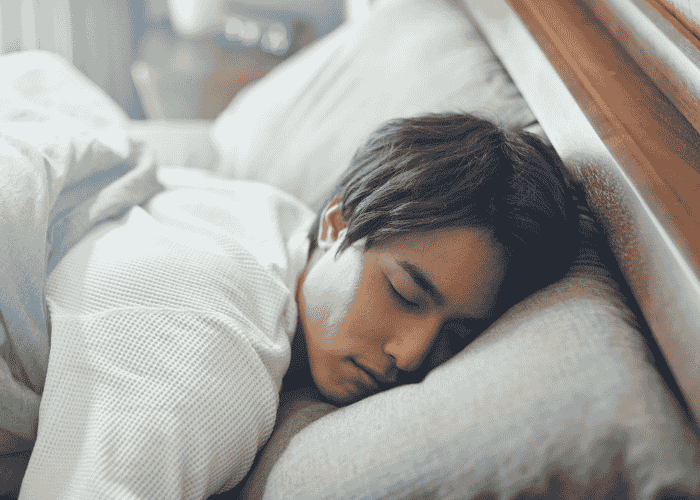
Mission Prep: Encouraging Adolescent Mental Health Awareness
The team at Mission Prep is dedicated to providing as many mental health resources as possible for parents to learn about their child’s experience. By educating yourselves about sleep problems in teens, depression, anxiety, and other mental health struggles, you become better equipped to get your child the treatment they need.
If you’re worried that your child is suffering from sleep paralysis or any related mental health disorder, give us a call. We are here to answer questions, listen to your concerns, and provide recommendations for different therapies and interventions.
References
- Wang, Y. A., Li, Q., Zhong, Z., Ouyang, Q., Zou, X., Yue, K., & Yao, D. (2025). Sleep Paralysis: Pathogenesis, Clinical Manifestations, and Treatment Strategies. Journal of Integrative Neuroscience, 24(8), 38979.
- Uccella, S. et al. (2023). Sleep deprivation and insomnia in adolescence: implications for mental health. Brain sciences, 13(4), 569.
- Howarth, N. E., & Miller, M. A. (2024). Sleep, sleep disorders, and mental health: a narrative review. Heart and Mind, 8(3), 146-158.
- Qiu, J., & Morales-Muñoz, I. (2022). Associations between sleep and mental health in adolescents: results from the UK millennium cohort study. International journal of environmental research and public health, 19(3), 1868.
- Gradisar, M. et al. (2022). Sleep’s role in the development and resolution of adolescent depression. Nature Reviews Psychology, 1(9), 512-523.
- Arns, M., Kooij, J. S., & Coogan, A. N. (2021). Identification and management of circadian rhythm sleep disorders as a transdiagnostic feature in child and adolescent psychiatry. Journal of the American Academy of Child & Adolescent Psychiatry, 60(9), 1085-1095.
- Deshpande, P., Salcedo, B., & Haq, C. (2022). Common Sleep Disorders in Children. American family physician, 105(2), 168-176.

